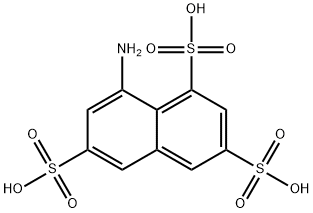1-Aminonaphthalene-3,6,8-trisulfonic acid [117-42-0]. (8-aminonaphthalene-1,3,6- trisulfonic acid), Koch acid, T acid, C10H9NO9S3, Mr 383.36, and its alkali-metal salts are readily soluble in water. The solutions are unusual for this class of compound in that they exhibit no fluorescence. Hydrolysis with dilute sulfuric acid produces 1-hydroxynaphthalene-3,6,8-trisulfonic acid, whereas diazotization followed by acid hydrolysis results in formation of the corresponding sultone. Reduction with zinc and alkali desulfonates 1-Aminonaphthalene-3,6,8-trisulfonic acid to give 1-amino-naphthalene-3,6-disulfonic acid. Amination gives 1,3-diaminonaphthalene-6,8- disulfonic acid.
Naphthalene in sulfuric acid solution is treated with gradual addition of 65 % oleum and temperature profiling (to 160℃) to optimize formation of the 1,3,6-trisulfonic acid. A mixture of sulfuric acid and nitric acids is added slowly at 40℃ to form 1-nitronaphthalene-3,6,8-trisulfonic acid (nitro-Koch acid) which is converted to neutral liquor by liming out. The liquor is reduced with iron powder in the presence of acetic acid and, after removal of iron residues, the crude product is isolated, as the acid calcium – sodium salt. This is purified by dissolution with sodium carbonate and removal of calcium carbonate. The trisodium salt liquor is concentrated before direct use in H acid manufacture. To obtain pure Koch acid, the 1-nitro3,6,8-trisulfonic acid can be isolated before reduction. The reduction step can alternatively be carried out by hydrogenation of the aqueous solution of nitro-Koch acid in the presence of a nickel catalyst.

